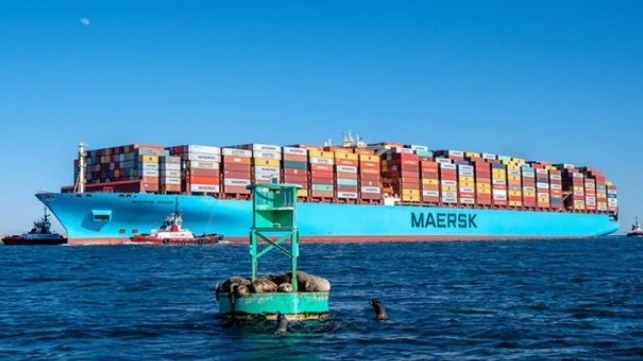
LOS ANGELES, Jan 24 (NNN-Xinhua) — AP Moller-Maersk, one of the world’s biggest integrated container logistics company, confirmed one of its container ships from China to the United States lost several hundred containers during rough sea conditions in the Pacific Ocean.
About 750 containers from the Maersk Essen fell overboard on Jan 16 while sailing from the eastern Chinese city of Xiamen, to Los Angeles, the Danish company said in a statement, adding that all crew members are safe, and a detailed assessment of the cargo is ongoing while the vessel continues its journey.
The Port of Long Beach and the Port of Los Angeles in the San Pedro Bay Port Complex handle approximately 40 percent of containerized imports and 30 percent exports for the United States.
The ship changed course and is sailing for the Port of Lazaro Cardenas in Mexico with an estimated arrival date of Jan 29 “for cargo survey, port operations and initial repair.”
So far, it is too early to estimate the tolls of the latest accident, according to FreightWaves’ SONAR data, which focuses on global supply chain and logistic information. The Maersk Essen carried more than 4,000 TEUs of furniture, nearly 850 TEUs of footwear and some 170 TEUs of electronics, 150 TEUs tires and 79 TEUs of kitchenware.
A report from FreightWaves also said the ship turned to Mexico because San Pedro Bay is currently filled with container ships waiting to berth, and port congestion apparently has been worsening. A total of 45 vessels were anchored outside the ports of Los Angeles and Long Beach, jumping from the 32 at anchor a week earlier.
Bad weather was blamed for the accident as AP Moller-Maersk said the ship “experienced heavy seas during her North Pacific crossing.” However, business insiders said the accident showed the high strain of cargo freight between China and America’s West Coast.
“Containerships are traveling fully laden with goods from China to the U.S. this year as freight rates surge to record highs and companies restock inventories,” Transport Topic, a leading logistics and trucking news supplier in the United States, said in a report. Thus, those large containerships had to travel at maximum speeds.
Winter in the North Pacific is notorious for bringing extreme weather and heavy seas, but the challenges could be overcome by the shipmaster slowing down, Clive Reed, founder of Reed Marine Maritime Casualty Management Consultancy, was quoted by the report as saying
“However, current freight rates are high, and there is commercial pressure on the ships to arrive on time and consequently make more voyages,” Reed said. “These tight schedules leave the master little room to literally maneuver.”
The suggestion was proved by the ports in Southern California. The Port of Los Angels Executive Director Gene Seroka disclosed that during the week before Christmas last year, the port handled 94 percent more traffic than the same week in 2019.
“In 2020, under the weight of the surge, everybody in the cargo industry took a hit from ocean carriers all the way to your local package delivery vans. All of us were stretched. No one escaped criticism, and we are still moving extraordinary levels of cargo,” he said.
The Maersk Essen was one of many cargo ships that have suffered a heavy container loss while sailing through rough seas in recent months.
The incident came after the ONE Apus container vessel lost 1,816 containers in November last year en route from Yantian Port in China’s southern city of Shenzhen to the Port of Long Beach. — NNN-XINHUA




